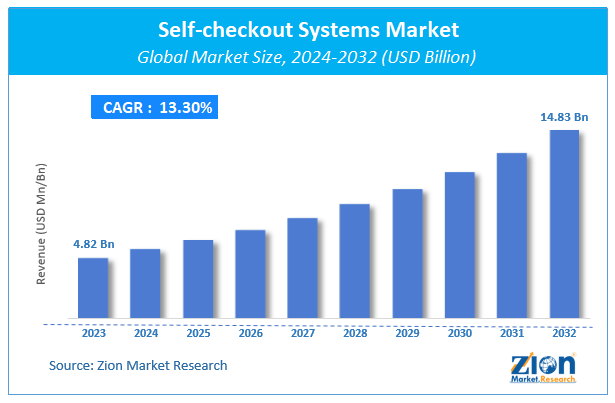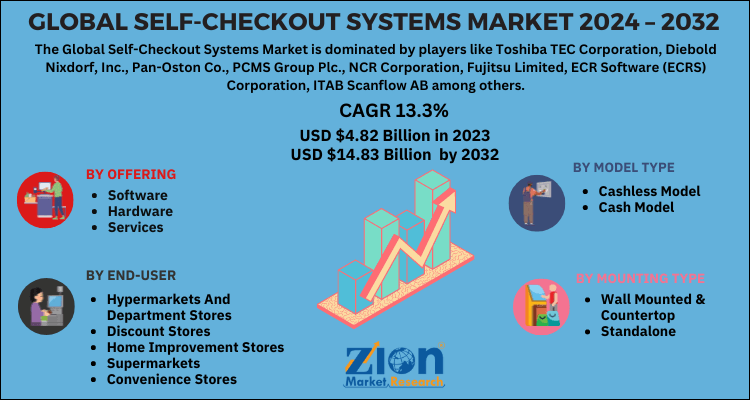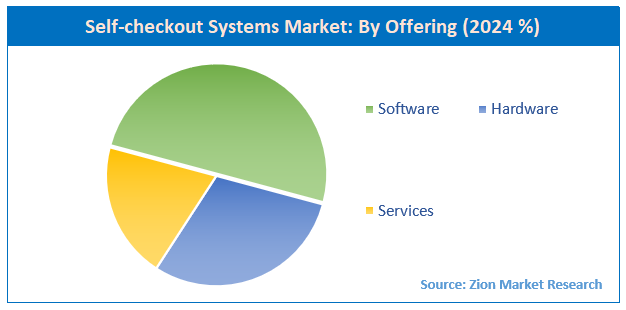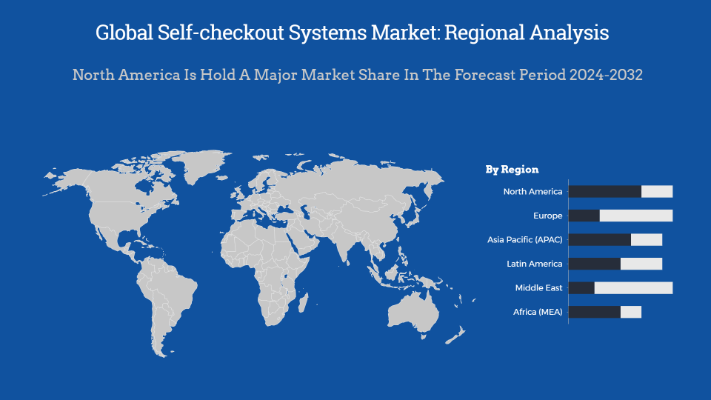Self-checkout Systems Market Size, Share, Trends and Forecast, 2032

Self-checkout Systems Market By Offering(Software, Hardware, And Services), By Model Type(Cashless Model And Cash Model), By Mounting Type(Wall Mounted & Countertop And Standalone), By End-User(Hypermarkets And Department Stores, Discount Stores, Home Improvement Stores, Supermarkets, Convenience Stores, Specialty Stores, Pharmacies, Appliance Stores, And Warehouses), By Region - Global And Regional Industry Overview, market Intelligence, Comprehensive Analysis, Historical Data, And Forecasts 2024-2032
| Market Size in 2023 | Market Forecast in 2032 | CAGR (in %) | Base Year |
|---|---|---|---|
| USD 4.82 Billion | USD 14.83 Billion | 13.3% | 2023 |
Description
Global Self-checkout Systems Market: Insights
The global Self-checkout Systems market size was worth around USD 4.82 billion in 2023 and is predicted to grow to around USD 14.83 billion by 2032 with a compound annual growth rate (CAGR) of roughly 13.3% between 2024 and 2032. The study provides historical data from 2018 to 2022 along with a forecast from 2024 to 2032 based on revenue (USD billion). The report covers a forecast and an analysis of the Self-checkout Systems market on a global and regional level.
Key Insights
- As per the analysis shared by our research analyst, the self-checkout systems market is anticipated to grow at a CAGR of 13.3% during the forecast period (2024-2032).
- The global self-checkout systems market was estimated to be worth approximately USD 4.82 billion in 2023 and is projected to reach a value of USD 14.83 billion by 2032.
- The growth of the self-checkout systems market is being driven by rising adoption of automation and contactless technologies in the retail sector.
- Based on the offering, the software segment is growing at a high rate and is projected to dominate the market.
- On the basis of model type, the cashless model segment is projected to swipe the largest market share.
- In terms of mounting type, the wall mounted & countertop segment is expected to dominate the market.
- Based on the end-user, the hypermarkets and department stores segment is expected to dominate the market.
- By region, North America is expected to dominate the global market during the forecast period.
Global Self-checkout Systems Market: Overview
Self-checkout systems are a type of machines that help in processing the transactions. To be precise, it plays the role of cashier and offers different services. The self-checkout system scans the product and provides the details of the products along with its price automatically. The self-checkout systems are being used widely in several industrial domains.
Global Self-checkout Systems Market: Growth Factors
In the recent years, technology has developed drastically and there has been an increased demand for the touch-free transactions which is majorly contributing to the growth of the self-checkout systems market. In many of the retailing formats, the self-checkout systems have become the integral part which is fuelling the growth of the global market. There has been an increasing demand for the self-checkout systems in the entertainment sectors such as casinos, museums, movie theatres, sports arenas, and theme parks.
Development of the tourism sector in the developing nations has prompted the expansion of the self-checkout systems. The fact that the self-checkout systems have the facility of printing helps the transportation sector in employing the ticket vending kiosk for the tourists. In the recent years, most of the financial transactions are being carried out online with the help of the internet contributes largely to the development of the self-checkout systems market. The market players are investing a lot for the development of the technology in order to maintain the competitive edge in the global market.
Recent Development
- In October 2021, Instacart acquired Caper AI for approximately $350 million to advance its self-checkout capabilities. The acquisition enabled customers to scan and pay for items directly from AI-powered smart carts, streamlining the in-store experience.
- In February 2023, Standard AI acquired Skip, a mobile-based self-checkout company. By integrating Standard’s autonomous, camera-based technology with Skip’s scan-and-go app, the combined solution offers retailers a flexible, hybrid approach to self-checkout.
- In December 2023, Glory Global Solutions acquired Flooid, a cloud-based unified commerce software provider, to strengthen its self-checkout, POS, and omnichannel retail offerings across diverse formats.
- In early 2024, Cantaloupe Inc. acquired Cheq Lifestyle Technology, a mobile ordering and payment platform tailored for stadiums and entertainment venues. This move expanded Cantaloupe’s self-service footprint beyond vending into hospitality and live event retail.
- Throughout 2024 and into 2025, Diebold Nixdorf deployed its Vynamic® Smart Vision I “Shrink Reduction” solution across multiple retailers. Trials demonstrated a drop in error rates from approximately 3% to below 1%, and a 15% reduction in manual interventions at self-service checkouts.
- Also in 2024, Diebold Nixdorf introduced Smart Vision age verification technology at self-checkout terminals, including in the EDEKA Jaeger 24/7 store at Stuttgart Airport, automating the sale of age-restricted items.
- In January 2025, GK Software acquired Nomitri GmbH, a German startup specializing in lightweight AI and computer vision for retail. The acquisition aimed to enhance product recognition, reduce hardware costs, and improve visual intelligence at self-checkout terminals.
Global Self-checkout Systems Market: Report Scope
| Report Attributes | Report Details |
|---|---|
| Report Name | Self-checkout Systems Market |
| Market Size in 2023 | USD 4.82 Billion |
| Market Forecast in 2032 | USD 14.83 Billion |
| Growth Rate | CAGR of 13.3% |
| Number of Pages | 220 |
| Key Companies Covered | Toshiba TEC Corporation, Diebold Nixdorf, Inc., Pan-Oston Co., PCMS Group Plc., NCR Corporation, Fujitsu Limited, ECR Software (ECRS) Corporation, ITAB Scanflow AB among others |
| Segments Covered | By Offering, By Model Type, By Mounting Type, By The End-user Industry And By Region |
| Regions Covered | North America, Europe, Asia Pacific (APAC), Latin America, Middle East, and Africa (MEA) |
| Base Year | 2023 |
| Historical Year | 2018 to 2022 |
| Forecast Year | 2024 - 2032 |
| Customization Scope | Avail customized purchase options to meet your exact research needs. Request For Customization |
Global Self-checkout Systems Market: Segmentation
The global market for the self-checkout systems is fragmented into its offering, model type, mounting type, and the end-user industry. All the segments have been analyzed based on present and future trends and the market is estimated from 2024 to 2032.
Based on the Offering, the global market is segregated into software, hardware, and services.
Based on the Type of the Model, the market is categorized into cashless model and cash model.
Based on the type of Mounting, the market is divided into wall mounted & countertop and standalone.
Based on the End-User Industry, the market is bifurcated into hypermarkets and department stores, discount stores, home improvement stores, supermarkets, convenience stores, specialty stores, pharmacies, appliance stores, and warehouses.
The Regional segment includes the current and forecast demand for North America, Europe, Asia Pacific, Latin America, and the Middle East and Africa.
Self-checkout Systems Market Dynamics
Key Growth Drivers
The Self-checkout Systems market is experiencing robust growth driven by retailers' increasing demand for faster, more efficient, and automated checkout solutions. The proliferation of e-commerce has heightened consumer expectations for speed and convenience, and self-checkout systems directly address this by reducing wait times and improving customer flow. Furthermore, a widespread labor shortage in the retail sector, coupled with rising labor costs, is compelling businesses to adopt automation to reduce their dependency on human cashiers and optimize operational expenses. The growing consumer preference for contactless and hygienic shopping experiences, accelerated by recent global public health concerns, has also been a major catalyst, as self-checkout systems offer a way to complete transactions with minimal human interaction.
Restraints
Despite the clear benefits, the self-checkout systems market faces several significant restraints. The high initial investment and ongoing maintenance costs can be a major financial barrier for small and medium-sized retailers, making it difficult for them to compete with larger chains. Another significant challenge is the increased risk of theft and fraud, often referred to as "shrinkage." The absence of a dedicated cashier and the potential for scanning errors can be exploited by dishonest customers, leading to substantial financial losses for retailers. Additionally, a portion of the customer base, particularly older individuals or those less comfortable with technology, may be reluctant to use these systems due to a lack of familiarity or a preference for human interaction, which can lead to customer frustration and a negative shopping experience.
Opportunities
The Self-checkout Systems market is ripe with opportunities for innovation and expansion. The integration of advanced technologies like Artificial Intelligence (AI) and computer vision is a key growth avenue. AI-powered systems can use object recognition to identify products without barcodes, minimize scanning errors for fresh produce, and automatically detect and prevent theft. The development of mobile-based "scan-and-go" solutions is another major opportunity, as it allows customers to use their own smartphones to scan and pay for items, thereby eliminating the need for a physical kiosk and offering a frictionless shopping experience. Furthermore, the market is expanding beyond the traditional retail sector into non-retail industries like hospitality, entertainment, and transportation, where self-service kiosks can be used for ticketing, ordering, and check-in.
Challenges
The Self-checkout Systems market faces a number of complex challenges. A major challenge is the inherent technical complexity of the systems, which can lead to malfunctions, software glitches, and payment errors that disrupt the checkout process and frustrate customers. The industry must also address the need for a standardized and user-friendly interface across different vendors and systems to reduce customer confusion and ensure a consistent experience. The ongoing battle against theft and fraud requires continuous investment in new security measures and software updates, which adds to the operational costs for retailers. Lastly, the industry must manage the perception that self-checkout systems eliminate jobs and dehumanize the shopping experience, which can be a point of contention for both employees and consumers.
Global Self-checkout Systems Market: Regional Analysis
The dominant position in the self-checkout systems market is held by the North America which is followed by Europe and Asia Pacific. In North America, it is the U.S. that has the maximum share in the market followed by Mexico and Canada. The factor that contributes to the growth of the market in these regions is the large existence of the hypermarkets, supermarkets, and others wherein the self-checkout systems are being used widely. The market is expanding significantly in the Asia Pacific region. The market is also flourishing in the Latin American region and Argentina and Brazil are the major contributors. In Asia Pacific region, the emerging economies such as China and Japan contribute the major share in the market growth. This growth is due to the expanding e-commerce industry in Asia Pacific region.
Global Self-checkout Systems Market: Competitive Players
The key market players that are involved in the self-checkout systems market include:
- Toshiba TEC Corporation
- Diebold Nixdorf Inc.
- Pan-Oston Co.
- PCMS Group Plc.
- NCR Corporation
- Fujitsu Limited
- ECR Software (ECRS) Corporation
- ITAB Scanflow AB
- Among others
The Global Self-checkout Systems Market is segmented as follows:
By Offering
- Software
- Hardware
- Services
By Model Type
- Cashless Model
- Cash Model
By Mounting Type
- Wall Mounted & Countertop
- Standalone
By End-User
- Hypermarkets And Department Stores
- Discount Stores
- Home Improvement Stores
- Supermarkets
- Convenience Stores
- Specialty Stores
- Pharmacies
- Appliance Stores
- Warehouses
Global Self-checkout Systems Market: Regional Segment Analysis
- North America
- U.S.
- Europe
- UK
- France
- Germany
- Asia Pacific
- China
- Japan
- India
- Latin America
- Brazil
- Middle East and Africa
What Reports Provides
- Full in-depth analysis of the parent market
- Important changes in market dynamics
- Segmentation details of the market
- Former, on-going, and projected market analysis in terms of volume and value
- Assessment of niche industry developments
- Market share analysis
- Key strategies of major players
- Emerging segments and regional markets
- Testimonials to companies in order to fortify their foothold in the market.
Table Of Content
FrequentlyAsked Questions
Self-checkout systems are a type of machines that help in processing the transactions. To be precise, it plays the role of cashier and offers different services.
According to study, the Self-checkout Systems Market size was worth around USD 4.82 billion in 2023 and is predicted to grow to around USD 14.83 billion by 2032.
The CAGR value of Self-checkout Systems Market is expected to be around 13.3% during 2024-2032.
North America has been leading the Self-checkout Systems Market and is anticipated to continue on the dominant position in the years to come.
The Self-checkout Systems Market is led by players like Toshiba TEC Corporation, Diebold Nixdorf, Inc., Pan-Oston Co., PCMS Group Plc., NCR Corporation, Fujitsu Limited, ECR Software (ECRS) Corporation, ITAB Scanflow AB among others.
HappyClients
Zion Market Research
Tel: +1 (302) 444-0166
USA/Canada Toll Free No.+1 (855) 465-4651
3rd Floor,
Mrunal Paradise, Opp Maharaja Hotel,
Pimple Gurav, Pune 411061,
Maharashtra, India
Phone No +91 7768 006 007, +91 7768 006 008
US OFFICE NO +1 (302) 444-0166
US/CAN TOLL FREE +1 (855) 465-4651
Email: sales@zionmarketresearch.com
We have secured system to process your transaction.
Our support available to help you 24 hours a day, five days a week.
Monday - Friday: 9AM - 6PM
Saturday - Sunday: Closed








